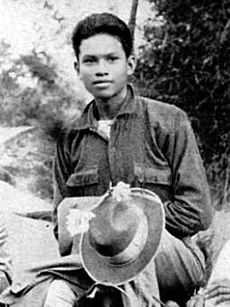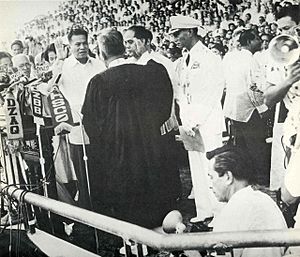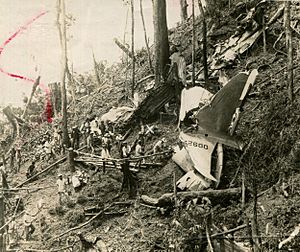Ramon Magsaysay facts for kids
Quick facts for kids
Ramon F. Magsaysay
QSC GCGH KGE GCC
|
|
|---|---|
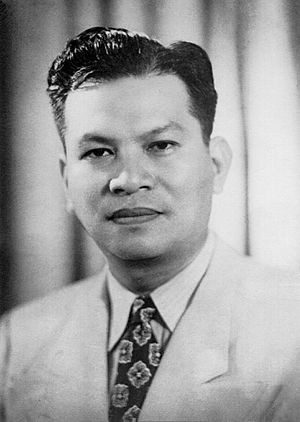 |
|
| 7th President of the Philippines | |
| In office December 30, 1953 – March 17, 1957 |
|
| Vice President | Carlos P. Garcia |
| Preceded by | Elpidio Quirino |
| Succeeded by | Carlos P. Garcia |
| Secretary of National Defense | |
| In office January 1, 1954 – May 14, 1954 |
|
| President | Himself |
| Preceded by | Oscar Castelo |
| Succeeded by | Sotero B. Cabahug |
| In office September 1, 1950 – February 28, 1953 |
|
| President | Elpidio Quirino |
| Preceded by | Ruperto Kangleon |
| Succeeded by | Oscar Castelo |
| Member of the Philippine House of Representatives from Zambales’ at-large district | |
| In office May 28, 1946 – September 1, 1950 |
|
| Preceded by | Valentin Afable |
| Succeeded by | Enrique Corpus |
| Personal details | |
| Born |
Ramon del Fierro Magsaysay
August 31, 1907 Iba, Zambales, Philippine Islands |
| Died | March 17, 1957 (aged 49) Balamban, Cebu, Philippines |
| Cause of death | Airplane crash |
| Resting place | Manila North Cemetery, Santa Cruz, Manila, Philippines |
| Political party | Nacionalista (1953–1957) Liberal (1946–1953) |
| Height | 5 ft 11 in (180 cm) |
| Spouse |
Luz Banzon
(m. 1933) |
| Children |
|
| Alma mater | University of the Philippines José Rizal University (BComm) |
| Profession | Soldier, automotive mechanic |
| Signature | |
| Nicknames | Monching, Mambo |
| Military service | |
| Allegiance | |
| Branch/service | Philippine Commonwealth Army |
| Years of service | 1942–1945 |
| Rank | Captain |
| Unit | 31st Infantry Division |
| Battles/wars | World War II
|
Ramon del Fierro Magsaysay Sr. (August 31, 1907 – March 17, 1957) was the seventh president of the Philippines. He served from December 30, 1953, until his sudden death in an airplane crash on March 17, 1957.
Before becoming president, Magsaysay was an automobile mechanic. He became known as a brave guerrilla leader during World War II. After the war, he was appointed military governor of Zambales. He then served two terms as a congressman for Zambales before President Elpidio Quirino made him Secretary of National Defense. He was elected president under the Nacionalista Party.
Ramon Magsaysay was the first Philippine president born in the 20th century. He was also the first to be born after the Spanish colonial era ended.
Contents
Life Story of Ramon Magsaysay
Ramon del Fierro Magsaysay was born in Iba, Zambales on August 31, 1907. His father, Exequiel Magsaysay, was a blacksmith. His mother, Perfecta del Fierro, was a schoolteacher and nurse. His family had mixed Filipino and Chinese roots.
He went to grade school in Castillejos and high school at Zambales Academy. In 1927, he studied medicine at the University of the Philippines. To pay for his studies, he worked as a chauffeur. Later, he switched to business studies at José Rizal College (now José Rizal University). He earned a degree in commerce in 1932. After college, he worked as an automobile mechanic and a shop superintendent for a bus company.
Magsaysay's Role in World War II

When World War II started, Ramon Magsaysay joined the Philippine Army. He worked in the motor pool of the 31st Infantry Division.
When the Battle of Bataan ended in 1942, Magsaysay escaped to the hills. He avoided being captured by the Japanese several times. In the hills, he formed the Western Luzon Guerrilla Forces. He became a captain on April 5, 1942. For three years, he led a strong force of 10,000 fighters.
Magsaysay and his guerrillas helped clear the Zambales coast of Japanese forces. This made it easier for American and Philippine Commonwealth troops to land there in January 1945.
Magsaysay's Family Life
Ramon Magsaysay married Luz Rosauro Banzon on June 16, 1933. They had three children:
- Teresita (1934–1979)
- Milagros (born 1936)
- Ramon Jr. (born 1938)
Several of his relatives also became important public figures:
- Ramon "Jun" Banzon Magsaysay Jr. (son): Former Congressman and Senator.
- Genaro Magsaysay (brother): Former Senator.
- Vicente Magsaysay (nephew): Former Governor of Zambales.
- Antonio M. Diaz (nephew): Congressman and Assemblyman of Zambales.
- Anita Magsaysay-Ho (cousin): A famous painter.
Serving in Congress
On April 22, 1946, Magsaysay was elected to the House of Representatives of the Philippines. He ran under the Liberal Party. His fellow former guerrillas encouraged him to run.
In 1948, President Manuel Roxas sent Magsaysay to Washington, D.C.. He was in charge of helping pass a bill that would give benefits to Philippine war veterans. In 1949, he was re-elected for a second term. During both terms, he led the House National Defense Committee.
Secretary of National Defense Role
In August 1950, Magsaysay presented President Elpidio Quirino with a plan to fight the Communist guerrillas. He used his own experience from World War II. In September 1950, Quirino appointed Magsaysay as Secretary of National Defense.
Magsaysay greatly increased the fight against the Hukbalahap guerrillas. He used new methods, like having soldiers give aid to rural communities. Before Magsaysay, people in the countryside did not trust the Philippine Army. But Magsaysay's leadership improved the Army's image and earned them respect.
By 1953, President Quirino felt the Huk threat was under control. He thought Magsaysay was becoming too powerful. Magsaysay faced problems from the President's team. They worried he might run for president. Magsaysay decided that the only way to continue fighting communism and corruption was to become president himself. He resigned as defense secretary on February 28, 1953. He then became the presidential candidate for the Nacionalista Party.
The Moises Padilla Incident
In 1951, Magsaysay learned that his political friend, Moises Padilla, was being harmed by men of Governor Rafael Lacson. Magsaysay rushed to Negros Occidental, but it was too late. Padilla's body was found with many bullet wounds. Magsaysay himself carried Padilla's body to the morgue. Pictures of him doing this appeared in newspapers the next day. Magsaysay used this event in his presidential campaign.
The trial against Governor Lacson began in January 1952. Magsaysay and his team provided enough proof to convict Lacson and his 26 men for murder. In August 1954, they were found guilty and sentenced.
Presidential Campaign of 1953
Presidential elections were held on November 10, 1953. Ramon Magsaysay won against the current President Elpidio Quirino. This was the first time an elected Philippine President did not come from the Senate. Magsaysay also started the trend of using "campaign jingles" during elections.
The United States Government had a strong influence on this election. Candidates tried hard to get U.S. support.
Magsaysay's Presidency
| Presidential styles of Ramon Magsaysay |
|
|---|---|
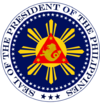 |
|
| Reference style | His Excellency |
| Spoken style | Your Excellency |
| Alternative style | Mr. President |
In the 1953 election, Magsaysay was chosen as president. He took his oath of office wearing the Barong Tagalog, which was a first for a Philippine President. People called him "Mambo Magsaysay."
As president, he was a strong supporter of the United States. He also spoke out against communism during the Cold War. He helped create the Southeast Asia Treaty Organization (SEATO) in 1954. This group aimed to stop communist movements in Southeast Asia.
During his time, he made Malacañang Palace a "house of the people." He opened its gates to the public. He even paid for his own flights on government planes. He helped people trust the military and the government again.
Helping the People
President Magsaysay wanted to bring the government closer to the people. On his inauguration day, he opened the gates of Malacañang Palace to everyone. People were allowed to visit the Palace freely. Later, this was changed to weekly visits.
He kept his promise to help the people. He created the Presidential Complaints and Action Committee (PCAC). This group listened to people's problems and helped solve them. The PCAC received nearly 60,000 complaints in one year. More than 30,000 were solved directly. This committee helped people trust their government again.
Land Reform for Farmers
President Magsaysay worked to help farmers and people in rural areas. He created the National Resettlement and Rehabilitation Administration (NARRA). This group helped give land to thousands of poor families and former rebels.
He also set up the Agricultural Credit and Cooperative Financing Administration (ACCFA). This group gave loans to farmers with low interest rates.
Magsaysay also started a campaign to build artesian wells (water wells). A group called the Liberty Wells Association raised money for this. These wells greatly improved life for people in the countryside. He also supported large irrigation projects and power plants.
He passed several laws to help with land reform:
- Republic Act No. 1160 (1954): Created NARRA to resettle farmers and former rebels.
- Republic Act No. 1199 (1954): Set rules for landowners and tenant farmers. It protected tenants' rights.
- Republic Act No. 1400 (1955): Created the Land Tenure Administration (LTA). This group bought large farmlands and gave them to landless farmers.
- Republic Act No. 821: Provided low-interest loans to small farmers.
Ending the Huk Rebellion
In early 1954, Magsaysay asked Benigno Aquino Jr. to talk to Luis Taruc. Taruc was the leader of the Hukbalahap rebel group.
With strong campaigns against the Huks, their numbers dropped. By 1954, there were less than 2,000 Huks. They no longer posed a serious threat. Taruc surrendered on May 17, 1954. Cleanup operations continued, and by the end of 1955, there were less than 1,000 Huks left.
Foreign Relations
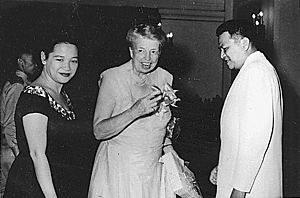
President Magsaysay's government actively fought against the spread of communism in Asia. He made the Philippines a member of the Southeast Asia Treaty Organization (SEATO). This group was formed in Manila on September 8, 1954. SEATO members were worried about communism spreading in Southeast Asia.
Magsaysay's government also worked with Japan to create the Reparation Agreement. This agreement made Japan pay $550 million to the Philippines for war damages.
Laurel-Langley Agreement

The Magsaysay administration negotiated the Laurel-Langley Agreement. This was a trade agreement between the Philippines and the United States. It was signed in 1955 and ended in 1974. This agreement gave the Philippines more freedom to develop its industries. It also allowed the Philippines to continue selling goods to the U.S. market.
This agreement replaced the old Bell Trade Act. The Bell Trade Act had tied the Philippine economy too closely to the U.S. economy.
Bandung Conference
In April 1955, the Asian–African Conference was held in Bandung, Java. It was a meeting of Asian and African nations. The goal was to promote cooperation and oppose colonialism.
At first, Magsaysay's government was unsure about sending a delegation. But Ambassador Carlos P. Rómulo convinced them to participate. Rómulo led the Philippine team. He strongly argued against countries being neutral in the Cold War. He said that being controlled by any power was wrong. The Philippine delegation successfully represented the country's interests at the conference.
Magsaysay's Death
Magsaysay's term as president was supposed to end on December 30, 1957. But it was cut short by a plane crash. On March 16, 1957, Magsaysay flew from Manila to Cebu City. He gave speeches at three schools there. That night, around 1 AM, he boarded his presidential plane, "Mt. Pinatubo," a C-47, to fly back to Manila.
In the early morning of March 17, the plane was reported missing. Later that afternoon, news reported that the plane had crashed on Mt. Manunggal in Cebu. Out of 25 people on board, 24 were killed, including Magsaysay. Only one person, newspaperman Nestor Mata, survived.
Vice-President Carlos García was in Australia at the time. He returned to Manila and became president. He served the remaining eight months of Magsaysay's term.
An estimated 2 million people attended Magsaysay's state funeral on March 22, 1957. He was later called the "Champion of the Masses" and "Defender of Democracy."
Magsaysay's Legacy
Magsaysay's time as president is remembered as one of the cleanest and most honest in Philippine history. Many call his rule the Philippines' "Golden Years." During his presidency:
- Trade and industry grew.
- The Philippine military was strong.
- The country gained international recognition in sports, culture, and foreign affairs.
- The Philippines was ranked as one of Asia's clean and well-governed countries.
His presidency focused on the people. Filipinos trusted their government more. He was called the "Champion of the masses" because he cared about ordinary people. He understood that the Huk rebels were not just communists. He saw them as peasants who felt rebellion was their only choice. He also worked to fix government corruption.
Awards and Honors
National Honors
 : Quezon Service Cross - awarded after his death (July 4, 1957)
: Quezon Service Cross - awarded after his death (July 4, 1957) : Order of the Golden Heart, Grand Collar - awarded after his death (March 17, 1958)
: Order of the Golden Heart, Grand Collar - awarded after his death (March 17, 1958)
Military Medals (Foreign)
 United States:
United States: : Commander, Legion of Merit (June 13, 1952)
: Commander, Legion of Merit (June 13, 1952)
Foreign Honors
 Thailand: Knight Grand Cordon (Special Class) of The Most Exalted Order of the White Elephant (April 1955)
Thailand: Knight Grand Cordon (Special Class) of The Most Exalted Order of the White Elephant (April 1955) Cambodia: Grand Cross of the Royal Order of Cambodia (January 1956)
Cambodia: Grand Cross of the Royal Order of Cambodia (January 1956)
See also
 In Spanish: Ramón Magsaysay para niños
In Spanish: Ramón Magsaysay para niños
- President of the Philippines
- Ramon Magsaysay Award
- Ramon Magsaysay, Jr.


